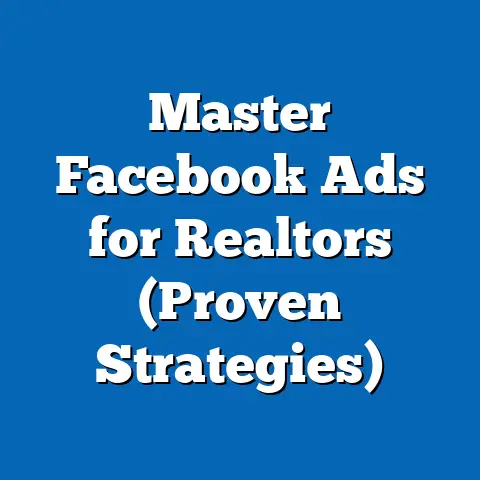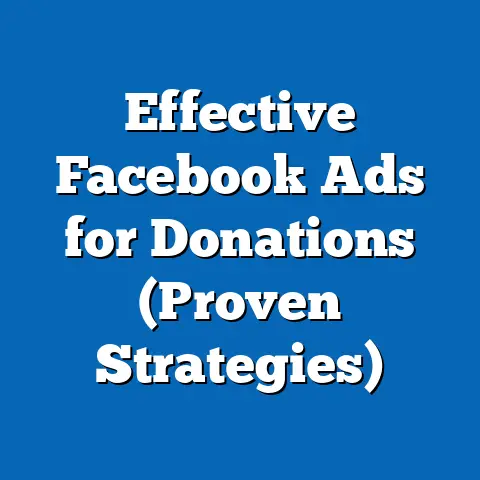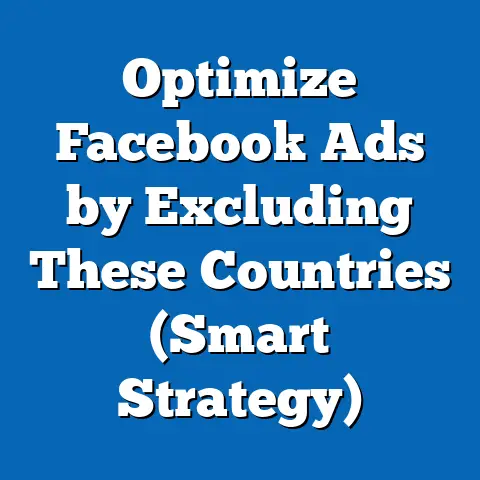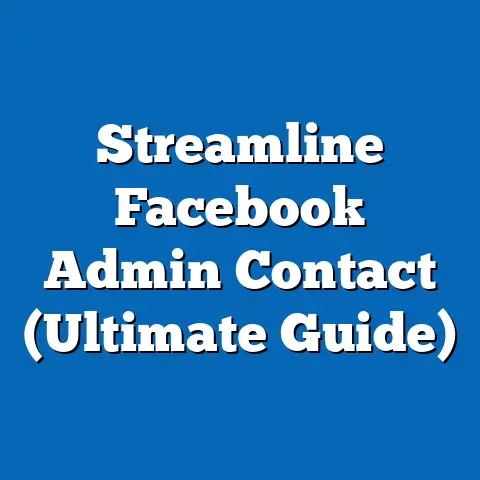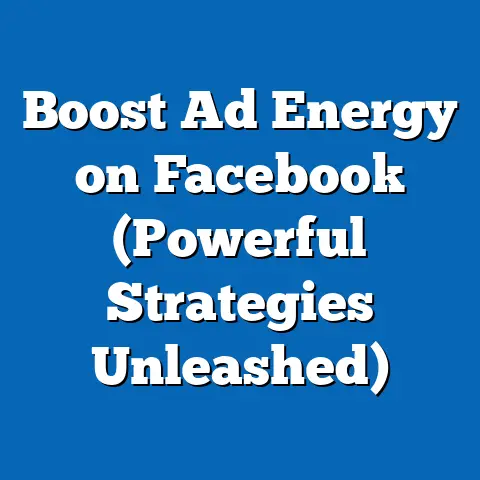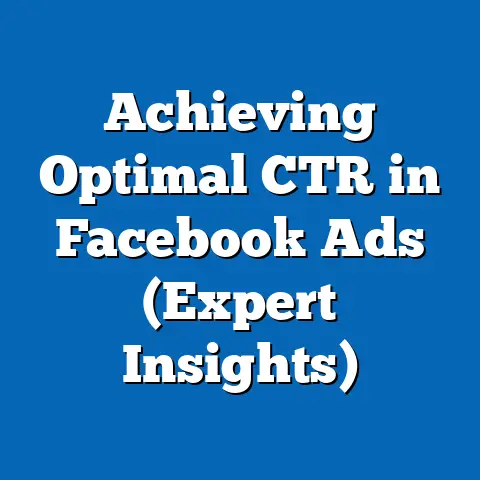Ditching Facebook Ads (Essential Strategies for Success)
The digital advertising landscape is a constantly shifting terrain. For years, Facebook ads reigned supreme, offering businesses of all sizes a seemingly direct line to their target audiences. I remember when I first started running Facebook ads for my own small business; it felt like I’d unlocked a secret weapon. The ability to pinpoint specific demographics and interests was revolutionary, and for a while, the ROI was fantastic.
But times change, and what was once a guaranteed win is now a much more complex game. Rising costs, algorithm shifts that seem to penalize even the most carefully crafted campaigns, and a growing sense of ad fatigue among users are all contributing to a feeling that Facebook ads are becoming less effective.
That’s why I’m writing this. While Facebook ads still have a place in some marketing strategies, I believe it’s crucial for businesses to explore alternative avenues for growth. Relying solely on a single platform, especially one as volatile as Facebook, is a recipe for disaster. This article will explore essential strategies for success that will allow businesses to thrive without depending solely on Facebook ads, offering a roadmap to a more diversified and sustainable marketing future.
The Limitations of Facebook Ads
In the early days of Facebook advertising, the platform offered an unparalleled opportunity to reach specific demographics with laser precision. I saw firsthand how targeted campaigns could drive significant traffic and conversions at a relatively low cost. It felt like a gold rush, with businesses eager to capitalize on the platform’s vast user base and sophisticated targeting capabilities.
However, the landscape has changed dramatically in recent years. Several factors have contributed to the diminishing returns experienced by many businesses heavily reliant on Facebook ads. Let’s break down the key limitations:
-
Increasing Competition and Costs: As more businesses flock to Facebook ads, competition for ad placements intensifies. This increased demand drives up ad costs, making it more expensive to reach the same audience. According to a recent report by Statista, the average cost-per-click (CPC) for Facebook ads has steadily increased over the past few years, putting a strain on marketing budgets, especially for smaller businesses.
-
Algorithm Changes Affecting Ad Visibility: Facebook’s algorithm is constantly evolving, often with little or no warning to advertisers. These changes can significantly impact ad visibility and reach, making it challenging to maintain consistent performance. I’ve personally experienced the frustration of seeing a perfectly optimized campaign suddenly tank due to an algorithm update. It’s a constant game of cat and mouse, requiring advertisers to stay on top of the latest changes and adapt their strategies accordingly.
-
Privacy Concerns and Potential Impacts on Targeting: In recent years, growing concerns about data privacy have led to stricter regulations and increased scrutiny of Facebook’s data collection practices. These changes have impacted the platform’s ability to offer precise targeting options, making it more difficult to reach specific demographics. Apple’s App Tracking Transparency (ATT) feature, for example, has significantly limited Facebook’s ability to track user activity across apps, impacting ad targeting and measurement.
-
User Fatigue and Ad Blindness: As users are bombarded with more and more ads on Facebook, they become increasingly adept at ignoring them. This phenomenon, known as ad blindness, reduces the effectiveness of even the most creative and well-targeted campaigns. I’ve noticed that users are becoming more discerning, seeking out authentic and engaging content rather than generic advertising.
Increasing Competition and Costs: As more businesses flock to Facebook ads, competition for ad placements intensifies. This increased demand drives up ad costs, making it more expensive to reach the same audience. According to a recent report by Statista, the average cost-per-click (CPC) for Facebook ads has steadily increased over the past few years, putting a strain on marketing budgets, especially for smaller businesses.
Algorithm Changes Affecting Ad Visibility: Facebook’s algorithm is constantly evolving, often with little or no warning to advertisers. These changes can significantly impact ad visibility and reach, making it challenging to maintain consistent performance. I’ve personally experienced the frustration of seeing a perfectly optimized campaign suddenly tank due to an algorithm update. It’s a constant game of cat and mouse, requiring advertisers to stay on top of the latest changes and adapt their strategies accordingly.
Privacy Concerns and Potential Impacts on Targeting: In recent years, growing concerns about data privacy have led to stricter regulations and increased scrutiny of Facebook’s data collection practices. These changes have impacted the platform’s ability to offer precise targeting options, making it more difficult to reach specific demographics. Apple’s App Tracking Transparency (ATT) feature, for example, has significantly limited Facebook’s ability to track user activity across apps, impacting ad targeting and measurement.
User Fatigue and Ad Blindness: As users are bombarded with more and more ads on Facebook, they become increasingly adept at ignoring them. This phenomenon, known as ad blindness, reduces the effectiveness of even the most creative and well-targeted campaigns. I’ve noticed that users are becoming more discerning, seeking out authentic and engaging content rather than generic advertising.
To illustrate the impact of these limitations, consider the case of a small e-commerce business that relied heavily on Facebook ads for customer acquisition. Initially, their campaigns were highly successful, driving a steady stream of traffic and sales. However, as competition increased and ad costs rose, their ROI began to decline. Despite optimizing their campaigns and experimenting with different targeting options, they struggled to maintain the same level of performance. Ultimately, they realized that they needed to diversify their marketing efforts to reduce their reliance on Facebook ads.
Takeaway: Facebook ads, while still a viable option for some businesses, are facing increasing limitations due to rising costs, algorithm changes, privacy concerns, and user fatigue. It’s essential to acknowledge these limitations and explore alternative marketing channels to ensure sustainable growth.
The Shift to Alternative Channels
Recognizing the limitations of relying solely on Facebook ads, many businesses are strategically shifting their focus to alternative marketing channels. This diversification allows them to mitigate risks associated with algorithm changes, reach new audiences, and build more sustainable growth strategies. I’ve personally advised numerous clients to explore these alternative channels, and the results have been overwhelmingly positive.
Here are some of the most popular and effective alternative digital marketing strategies:
-
Search Engine Optimization (SEO) and Content Marketing: SEO involves optimizing your website and content to rank higher in search engine results pages (SERPs). Content marketing focuses on creating valuable, informative, and engaging content that attracts and retains a target audience. Together, these strategies can drive organic traffic to your website, build brand authority, and generate leads. I’ve seen businesses achieve significant growth by investing in high-quality content and optimizing their websites for search engines.
-
Email Marketing and its Resurgence as a Powerful Tool: Despite being around for decades, email marketing remains one of the most effective digital marketing channels. Building an email list allows you to communicate directly with your target audience, nurture leads, and drive conversions. With the right strategy and compelling content, email marketing can deliver a high ROI. I’ve helped businesses build thriving email lists and create email campaigns that generate consistent revenue.
-
Influencer Marketing and Partnerships: Influencer marketing involves collaborating with individuals who have a strong following and influence within a specific niche. By partnering with influencers, you can reach a wider audience, build brand awareness, and drive sales. I’ve seen businesses achieve remarkable results by partnering with relevant influencers who align with their brand values and target audience.
-
Leveraging Platforms like TikTok, LinkedIn, or Pinterest Based on the Target Audience: Depending on your target audience, other social media platforms may offer more effective and cost-efficient advertising opportunities than Facebook. TikTok, for example, is popular among younger demographics, while LinkedIn is ideal for reaching professionals. Pinterest is a great platform for visual content and e-commerce businesses. I always advise businesses to research their target audience and identify the platforms where they are most active.
Search Engine Optimization (SEO) and Content Marketing: SEO involves optimizing your website and content to rank higher in search engine results pages (SERPs). Content marketing focuses on creating valuable, informative, and engaging content that attracts and retains a target audience. Together, these strategies can drive organic traffic to your website, build brand authority, and generate leads. I’ve seen businesses achieve significant growth by investing in high-quality content and optimizing their websites for search engines.
Email Marketing and its Resurgence as a Powerful Tool: Despite being around for decades, email marketing remains one of the most effective digital marketing channels. Building an email list allows you to communicate directly with your target audience, nurture leads, and drive conversions. With the right strategy and compelling content, email marketing can deliver a high ROI. I’ve helped businesses build thriving email lists and create email campaigns that generate consistent revenue.
Influencer Marketing and Partnerships: Influencer marketing involves collaborating with individuals who have a strong following and influence within a specific niche. By partnering with influencers, you can reach a wider audience, build brand awareness, and drive sales. I’ve seen businesses achieve remarkable results by partnering with relevant influencers who align with their brand values and target audience.
Leveraging Platforms like TikTok, LinkedIn, or Pinterest Based on the Target Audience: Depending on your target audience, other social media platforms may offer more effective and cost-efficient advertising opportunities than Facebook. TikTok, for example, is popular among younger demographics, while LinkedIn is ideal for reaching professionals. Pinterest is a great platform for visual content and e-commerce businesses. I always advise businesses to research their target audience and identify the platforms where they are most active.
The importance of diversifying marketing efforts cannot be overstated. Relying on a single platform, like Facebook, exposes businesses to significant risks. Algorithm changes, policy updates, and platform outages can all have a devastating impact on a business that is overly reliant on Facebook ads. By diversifying their marketing efforts, businesses can mitigate these risks and build more resilient growth strategies.
Takeaway: Diversifying marketing efforts by exploring alternative channels like SEO, content marketing, email marketing, influencer partnerships, and other social media platforms is crucial for mitigating risks and building sustainable growth strategies.
Building a Strong Organic Presence
While paid advertising can provide a quick boost in traffic and sales, building a strong organic presence is essential for long-term success. Organic reach refers to the number of people who see your content without you having to pay for it. A robust organic presence can lead to increased brand awareness, customer loyalty, and sustainable growth. I’ve always emphasized the importance of organic strategies to my clients, as they provide a foundation for long-term success.
Here are some key strategies for building organic reach on social media and other platforms:
-
Creating High-Quality, Engaging Content that Resonates with the Target Audience: Content is king, especially when it comes to organic reach. Creating valuable, informative, and engaging content is crucial for attracting and retaining a target audience. This content can take many forms, including blog posts, articles, videos, infographics, and social media updates. I always advise businesses to focus on creating content that solves problems, answers questions, or entertains their target audience.
-
Utilizing Community Engagement and Interaction to Foster Loyalty and Brand Awareness: Social media is all about building relationships and fostering a sense of community. Engaging with your audience, responding to comments and questions, and participating in relevant conversations can help build loyalty and brand awareness. I’ve seen businesses achieve remarkable results by actively engaging with their audience and creating a sense of community around their brand.
-
Implementing a Consistent Posting Schedule and Using Social Media Analytics to Optimize Performance: Consistency is key when it comes to social media. Posting regularly and maintaining a consistent brand voice can help keep your audience engaged and build brand recognition. Social media analytics can provide valuable insights into what content resonates with your audience, allowing you to optimize your posting schedule and content strategy. I always advise businesses to track their social media metrics and use data to inform their decisions.
Creating High-Quality, Engaging Content that Resonates with the Target Audience: Content is king, especially when it comes to organic reach. Creating valuable, informative, and engaging content is crucial for attracting and retaining a target audience. This content can take many forms, including blog posts, articles, videos, infographics, and social media updates. I always advise businesses to focus on creating content that solves problems, answers questions, or entertains their target audience.
Utilizing Community Engagement and Interaction to Foster Loyalty and Brand Awareness: Social media is all about building relationships and fostering a sense of community. Engaging with your audience, responding to comments and questions, and participating in relevant conversations can help build loyalty and brand awareness. I’ve seen businesses achieve remarkable results by actively engaging with their audience and creating a sense of community around their brand.
Implementing a Consistent Posting Schedule and Using Social Media Analytics to Optimize Performance: Consistency is key when it comes to social media. Posting regularly and maintaining a consistent brand voice can help keep your audience engaged and build brand recognition. Social media analytics can provide valuable insights into what content resonates with your audience, allowing you to optimize your posting schedule and content strategy. I always advise businesses to track their social media metrics and use data to inform their decisions.
Organic growth can lead to long-term customer relationships and brand advocacy. When customers feel connected to your brand and trust your content, they are more likely to become loyal customers and advocates for your business. These loyal customers can then help spread the word about your brand, driving even more organic growth.
Takeaway: Building a strong organic presence through high-quality content, community engagement, and consistent posting can lead to long-term customer relationships, brand advocacy, and sustainable growth.
Developing a Comprehensive Marketing Strategy
Moving away from a reliance on Facebook ads requires a comprehensive marketing strategy that integrates various channels and tactics. This strategy should be based on a deep understanding of your target audience, your business goals, and the competitive landscape. I’ve found that businesses with a well-defined marketing strategy are much more likely to achieve their goals and sustain long-term growth.
Here are the key elements of a comprehensive marketing strategy that doesn’t rely on Facebook ads:
-
Market Research and Understanding the Target Audience: The foundation of any successful marketing strategy is a deep understanding of your target audience. This involves conducting market research to identify their needs, preferences, and pain points. This research can take many forms, including surveys, focus groups, and customer interviews. I always advise businesses to spend time getting to know their target audience before developing their marketing strategy.
-
Integration of Various Marketing Channels (SEO, Email, Content, Social Media) for a Cohesive Approach: A comprehensive marketing strategy should integrate various marketing channels into a cohesive approach. This means ensuring that your SEO efforts, email marketing campaigns, content strategy, and social media activities are all aligned and working together to achieve your business goals. I’ve seen businesses achieve remarkable results by integrating their marketing channels and creating a seamless customer experience.
-
Actionable Steps for Creating a Marketing Plan that Focuses on Measurable Goals and KPIs: A marketing plan should outline the specific steps you will take to achieve your marketing goals. This plan should include measurable goals and key performance indicators (KPIs) that will allow you to track your progress and measure your success. I always advise businesses to set SMART goals (Specific, Measurable, Achievable, Relevant, and Time-bound) and track their KPIs regularly.
Market Research and Understanding the Target Audience: The foundation of any successful marketing strategy is a deep understanding of your target audience. This involves conducting market research to identify their needs, preferences, and pain points. This research can take many forms, including surveys, focus groups, and customer interviews. I always advise businesses to spend time getting to know their target audience before developing their marketing strategy.
Integration of Various Marketing Channels (SEO, Email, Content, Social Media) for a Cohesive Approach: A comprehensive marketing strategy should integrate various marketing channels into a cohesive approach. This means ensuring that your SEO efforts, email marketing campaigns, content strategy, and social media activities are all aligned and working together to achieve your business goals. I’ve seen businesses achieve remarkable results by integrating their marketing channels and creating a seamless customer experience.
Actionable Steps for Creating a Marketing Plan that Focuses on Measurable Goals and KPIs: A marketing plan should outline the specific steps you will take to achieve your marketing goals. This plan should include measurable goals and key performance indicators (KPIs) that will allow you to track your progress and measure your success. I always advise businesses to set SMART goals (Specific, Measurable, Achievable, Relevant, and Time-bound) and track their KPIs regularly.
Creating a marketing plan involves several steps, including:
- Defining your target audience: Identify your ideal customer and understand their needs, preferences, and pain points.
- Setting SMART goals: Define specific, measurable, achievable, relevant, and time-bound marketing goals.
- Identifying your marketing channels: Determine which marketing channels are most effective for reaching your target audience.
- Developing your content strategy: Create a plan for creating and distributing valuable, informative, and engaging content.
- Creating your budget: Allocate resources to each marketing channel based on its potential ROI.
- Tracking your results: Monitor your KPIs and adjust your strategy as needed.
Takeaway: A comprehensive marketing strategy that integrates various channels, is based on a deep understanding of the target audience, and focuses on measurable goals and KPIs is essential for sustainable growth.
Case Studies and Success Stories
The best way to illustrate the effectiveness of alternative marketing strategies is to share real-world examples of businesses that have successfully transitioned away from Facebook ads. These case studies provide inspiration and demonstrate that it is possible to achieve significant growth without relying solely on a single platform. I’ve personally witnessed numerous businesses achieve remarkable results by embracing these alternative strategies.
Here are a few inspiring case studies:
-
Case Study 1: The E-commerce Brand that Doubled Revenue with SEO and Content Marketing: A small e-commerce brand selling handmade jewelry decided to shift its focus from Facebook ads to SEO and content marketing. They invested in creating high-quality blog posts and articles about jewelry making, styling tips, and the history of different gemstones. They also optimized their website for search engines. Within six months, their organic traffic had doubled, and their revenue had increased by 50%. They found that customers who found their website through search engines were more likely to purchase their products and become repeat customers.
-
Case Study 2: The Local Restaurant that Built a Loyal Following with Email Marketing: A local restaurant decided to build an email list and send out weekly newsletters with special offers, menu updates, and behind-the-scenes stories. They offered a free appetizer to customers who signed up for their email list. Within a year, they had built a list of over 5,000 subscribers. They found that their email marketing campaigns consistently drove traffic to their restaurant and increased sales. They also used their email list to gather feedback from customers and improve their menu and service.
-
Case Study 3: The Tech Startup that Generated Leads with LinkedIn Influencer Marketing: A tech startup selling software to small businesses partnered with LinkedIn influencers in their industry. They created a series of webinars and blog posts with the influencers, promoting their software to their followers. Within three months, they had generated over 100 qualified leads and closed several new deals. They found that influencer marketing was a highly effective way to reach their target audience and build credibility.
Case Study 1: The E-commerce Brand that Doubled Revenue with SEO and Content Marketing: A small e-commerce brand selling handmade jewelry decided to shift its focus from Facebook ads to SEO and content marketing. They invested in creating high-quality blog posts and articles about jewelry making, styling tips, and the history of different gemstones. They also optimized their website for search engines. Within six months, their organic traffic had doubled, and their revenue had increased by 50%. They found that customers who found their website through search engines were more likely to purchase their products and become repeat customers.
Case Study 2: The Local Restaurant that Built a Loyal Following with Email Marketing: A local restaurant decided to build an email list and send out weekly newsletters with special offers, menu updates, and behind-the-scenes stories. They offered a free appetizer to customers who signed up for their email list. Within a year, they had built a list of over 5,000 subscribers. They found that their email marketing campaigns consistently drove traffic to their restaurant and increased sales. They also used their email list to gather feedback from customers and improve their menu and service.
Case Study 3: The Tech Startup that Generated Leads with LinkedIn Influencer Marketing: A tech startup selling software to small businesses partnered with LinkedIn influencers in their industry. They created a series of webinars and blog posts with the influencers, promoting their software to their followers. Within three months, they had generated over 100 qualified leads and closed several new deals. They found that influencer marketing was a highly effective way to reach their target audience and build credibility.
These case studies demonstrate that it is possible to achieve significant growth by embracing alternative marketing strategies. While the specific tactics may vary depending on the business and industry, the underlying principles remain the same: focus on creating valuable content, building relationships with your audience, and diversifying your marketing efforts.
Takeaway: Case studies demonstrate that businesses can successfully transition away from Facebook ads and achieve significant growth by embracing alternative marketing strategies like SEO, content marketing, email marketing, and influencer partnerships.
Conclusion
We’ve covered a lot of ground in this article, exploring the limitations of Facebook ads and the essential strategies for success that can help businesses thrive without relying solely on this platform. From understanding the evolving digital landscape to building a strong organic presence and developing a comprehensive marketing strategy, the key is to embrace a diversified and innovative approach to marketing.
I’ve shared my own experiences, provided real-world examples, and offered actionable tips to help you navigate this transition. Remember, while Facebook ads might have been a go-to for many marketers in the past, the future lies in diverse, sustainable strategies that can provide long-term growth.
Now, I encourage you to take a critical look at your current marketing strategies. Are you overly reliant on Facebook ads? Are you exploring alternative channels? Are you building a strong organic presence? The answers to these questions will help you identify areas for improvement and develop a roadmap for success.
Start by evaluating your current marketing performance. Identify the channels that are delivering the highest ROI and the areas where you are struggling. Then, begin to explore alternative marketing strategies that align with your business goals and target audience.
Don’t be afraid to experiment and try new things. The digital marketing landscape is constantly evolving, so it’s essential to stay agile and adapt to change. Embrace the challenges, learn from your mistakes, and celebrate your successes.
The future of marketing is not about relying on a single platform, but about building a diverse and sustainable strategy that can deliver long-term growth. So, ditch the reliance on Facebook ads and embrace the power of alternative marketing strategies. Your business will thank you for it.

